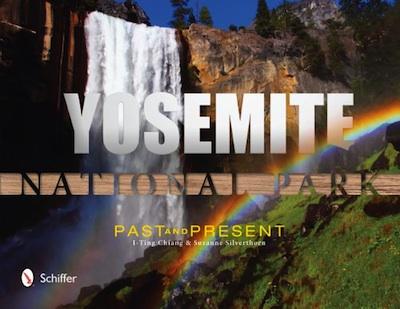
Yosemite National Park: Past and Present is first and foremost a picture book, each page a mosaic of historic postcards juxtaposed with recent photographs of Yosemite National Park. The book's key strength lies in the postcards, which offer entertaining and informative glimpses into Yosemite's past.
The more recent photographs provided by I-Ting Chiang encompass a wide variety of park views, including Yosemite's most iconic features, such as Half Dome, El Capitan, Yosemite Falls, the Merced and Tuolumne rivers, and giant sequoia trees; lodging facilities and visitor activities in the park; and lesser known places like the High Sierra Camps of Yosemite's backcountry. The text accompanying the postcards and photos provides an introduction into the park's long history as a favored travel destination.
The emphasis of this book is the human history that has unfolded in Yosemite since the California Gold Rush period, when Yosemite Valley was 'discovered' by people of European descent. The images and postcards reflect changes in transportation, infrastructure, and park use since the federal government granted the valley and the Mariposa Grove of giant sequoias to the state of California in 1864.
The book is very light on natural history. For example, seven pages are dedicated to the Mariposa grove of giant sequoias. Aside from mentioning the age and size of one tree, the Grizzly Giant, and including one sentence about controlled burns (which should read prescribed fires), there is no discussion of the unique natural history of these trees'their rarity, their narrow distribution, their relationship to fire, or the threat posed to them by climate change.
The 10-page section on wildlife offers very little in the way of information and should have been omitted completely or substantially improved. For example, the caption for a full page image of a coyote tells the reader that coyotes are regularly seen in Yosemite Valley. What appears to be the same coyote is also seen later in the book where it is shown standing next to a car begging for food.
In the two pages dedicated to mule deer, we learn that deer can inflict dangerous injuries if observers get too close; that deer are common in meadows and they feed on grasses, leaves, and twigs; and that male deer use their antlers during mating season.
Note that this is not a children's book.
There is a bit more information provided for bears. The authors mention management practices that are focused on reducing human-bear conflicts in one sentence. They could have expanded on this theme by discussing the trouble bears get into breaking into cars, tents, backpacks, etc., due to improper food storage by humans, and describe the significant steps the park has taken to reduce such incidents. The bear and deer postcards in this section, however, do illustrate an important point: how park management's view on wildlife has changed over time (from viewing animals as cute attractions to living, breathing entities worthy of respect and protection from humans).
More information on the changes in wildlife and vegetation that have occurred over time, especially in Yosemite Valley, would have enriched the book a great deal. For example, historic photos of Yosemite Valley that show more open meadows and fewer trees could be compared to the present-day scene to illustrate the deleterious (though unintended) effects of park management, specifically fire management. Of course, finding postcards to illustrate the historic state of vegetation would be next to impossible, which may be why the book was so limited in this area. Additionally, limiting the photographic images in the book to pictures taken by one photographer may be the reason the wildlife section was limited to a coyote, a bear, a couple of deer, a marmot, three squirrels, and five birds.
Yosemite National Park: Past and Present succeeds as a coffee table picture book of Euro-American human history and iconic Yosemite views, although the colors in the photographic images were too saturated for my taste. The text could have used a bit more editing and, on some pages, it is difficult to match the captions with the appropriate images or postcards. Readers also should note that some of the recreational activities pictured in the book are being phased out, including commercial horseback riding in Yosemite Valley and the tram tour in the Mariposa Grove.
Barbara J. Moritsch is the author of The Soul of Yosemite: Finding, Defending, and Saving the Valley's Sacred Wild Nature



Add comment